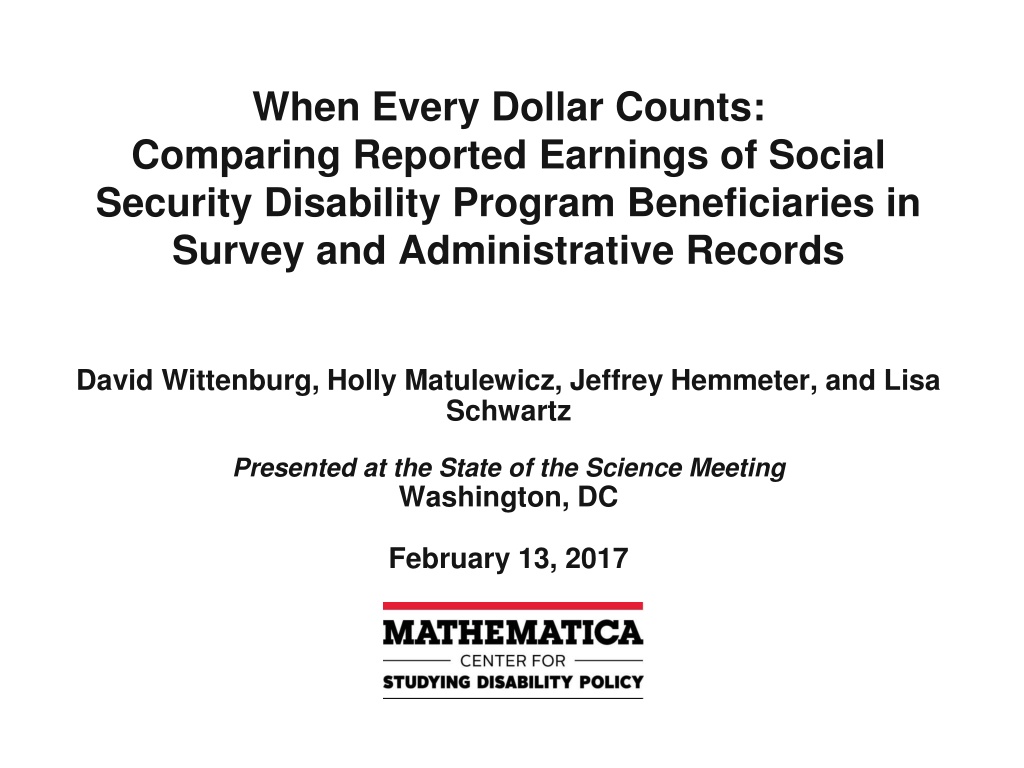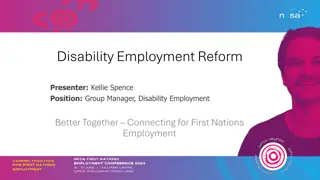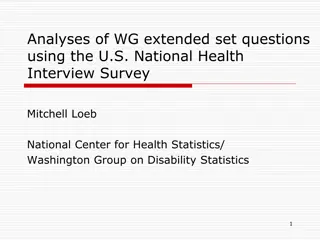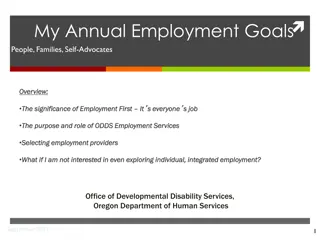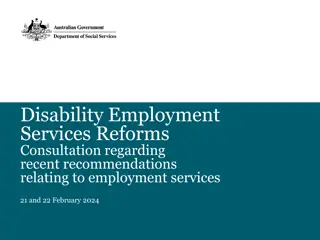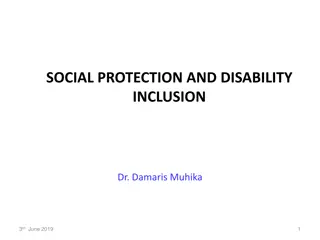Comparing Employment and Earnings Data of Social Security Disability Program Beneficiaries
This study compares reported earnings of Social Security Disability Program beneficiaries in survey and administrative records. The research highlights differences in employment rates and earnings estimates between the two data sources and aims to identify demographic and impairment subgroup variations within the beneficiary population. Various motivating factors and research questions are explored to enhance policy development and service targeting for individuals receiving Disability Insurance and Supplemental Security Income. The study utilizes the National Beneficiary Survey and Linked Social Security Administrative Data for comprehensive analysis.
- Social Security Disability Program
- Earnings Discrepancy
- Survey Data
- Administrative Records
- Policy Development
Download Presentation

Please find below an Image/Link to download the presentation.
The content on the website is provided AS IS for your information and personal use only. It may not be sold, licensed, or shared on other websites without obtaining consent from the author. Download presentation by click this link. If you encounter any issues during the download, it is possible that the publisher has removed the file from their server.
E N D
Presentation Transcript
When Every Dollar Counts: Comparing Reported Earnings of Social Security Disability Program Beneficiaries in Survey and Administrative Records David Wittenburg, Holly Matulewicz, Jeffrey Hemmeter, and Lisa Schwartz Presented at the State of the Science Meeting Washington, DC February 13, 2017
Administrative and Survey Data Differ in Employment and Earning Estimates Employment and earnings rates Consistently higher in administrative data relative to survey data 19.2 versus 13.6% employment rate for all beneficiaries 2 2
Policy and Research Interest in Social Security Disability Employment Rates Policy Develop policies and demonstrations Target services Research Survey design Understanding of subgroups 3 3
Motivation for Comparing Survey and Administrative Estimates Prior studies Focus: general population Administrative data: higher employment reports Limited information about disability beneficiaries Interests Policy: Develop policies and demonstrations and target services Research: Survey design 4 4
Research Questions 1. What are the Disability Insurance (DI) and Supplemental Security Income (SSI) employment rates and earnings levels? 2. Do these levels differ between survey and administrative data? 3. Do demographic and impairment subgroups differ from the overall beneficiary population? 5 5
Survey: National Beneficiary Survey (NBS) Study population DI and concurrent beneficiaries SSI-only recipients Ages 21 to 64 at time of interview Sample Pooled data: 2004, 2005, 2006 7,987 observations for sample members Outcomes Earnings and employment: previous year 6 6
Linked Social Security Administrative Data Master Earnings File (MEF) Compiled by Internal Revenue Service (IRS) All earnings reported to IRS Form W2, quarterly earnings records, annual income tax forms 7 7
Characteristics of Disability Beneficiaries Type of Survey Response Type of Beneficiary Gender 25.2 18.4 47.6 52.4 74.8 81.6 DI Only Concurrent Self-Report Proxy Report Male Female Age Group 36.0 40.0 35.0 25.2 30.0 23.5 Percent 25.0 20.0 11.1 15.0 10.0 4.2 5.0 0.0 21-29 30-39 40-49 50-59 60-64 Age Groups 8 8
Comparison of Annual Earnings Construction in MEF and NBS MEF NBS Constructed annual measure of earnings for prior year: Month, year start and stop Usual hours per week Usual number of weeks worked Rate and frequency of pay Aggregated at annual level 9 9
Key Findings 1 Administrative Data Show Higher Percentage of People Employed Overall and Across All Subgroups Type of Beneficiary 25 41% proportionate difference 19.5 19.2 19.1 20 Percent Employed 15 15.7 13.6 12.3 10 5 0 Overall DI Administrative Concurrent Survey 10 10
Key Findings 1 (cont.) Administrative Data Show Higher Percentage of People Employed Overall and Across All Subgroups Type of Survey Response Age 39.3 40 40 35 35 34.5 30.5 30 30 25 25 25.2 22.4 21.5 Percent 19.2 19.2 20 20 18.4 17.7 14.9 14.2 16.9 15 15 13.6 13.6 12.6 10 10 8.8 8.2 5 5 0 0 Overall 21-29 30-39 40-49 50-59 60-64 Overall Self-Report Proxy Administrative Survey Administrative Survey 11 11
Key Findings 2 Earnings Differences Are Substantial, with Pattern Reflected Across Subgroups Type of Beneficiary $2,000 $1,800 $1,600 118% $1,400 proportionate difference $1,258 $1,125 $1,200 $1,000 $732 $800 $600 $528 $514 $400 $470 $200 $0 Overall DI Only Concurrent Administrative Survey 12 12
Key Findings 2 (cont.) Earnings Differences Are Substantial, with Pattern Reflected Across Subgroups Type of Survey Response Age $1,767 $1,800 $1,800 $1,654 $1,600 $1,600 $1,369 $1,400 $1,400 $1,200 $1,125 $1,200 $1,125 $1,200 $1,235 $1,000 $1,000 $896 $886 $947 $793 $800 $800 $701 $600 $600 $514 $550 $514 $400 $400 $324 $352 $289 $200 $200 $0 $0 Overall Self Proxy Overall 21-29 30-39 40-49 50-59 60-64 Administrative Survey Administrative Survey 13 13
Employed in Both Administrative and Survey Data Restrict sample to employed in both survey and administrative data Higher estimates of earnings from administrative records $6,402 versus $4,181 Smaller proportionate difference (41%) compared with unconditional sample (118%) 14 14
What might drive the results for survey data on earnings? Recall issues Other factors Approximation Types of jobs held Study sponsor 15 15
Findings Have Important Implications for Researchers and Policymakers Administrative data produce higher employment and earnings rates than surveys Largest differences: subgroups with relatively lower employment rates Policy and research considerations Survey design Inform targeted efforts for demonstrations and services 16 16
Contact Information Center for Studying Disability Policy Mathematica Policy Research P.O. Box 2393, Princeton, NJ 08543 http://www.DisabilityPolicyResearch.org David Wittenburg dwittenburg@mathematica-mpr.com 17 17
Acknowledgments Grant funding from NIDILRR Social Security Administration Co-authors 18 18
This research was sponsored by the University of New Hampshire s Rehabilitation, Research, and Training Center on Employment Policy and Measurement, funded by the U.S. Department of Education (ED), National Institute on Disability Independent Living and Rehabilitation Research (cooperative agreement no. H133B100030). Contents of this presentation do not necessarily represent the policies of ED or of any other federal agency (EDGAR, 75.620 [b]). Authors are solely responsible for errors or omissions. 19 19
